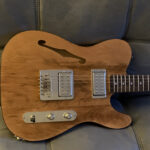When pondering, “How Much Does Guitar Center Pay for used guitars?”, it’s easy to focus solely on the transaction itself. However, the reality is far more nuanced when considering the profitability for a large retailer like Guitar Center (GC). It’s essential to look beyond the surface and understand the various operational costs involved.
One must account for considerable overheads. Guitar Center, like any retail business, incurs substantial employee costs, rent for often large store spaces, utilities such as electricity and heating, and of course, taxes. These expenses are constant, regardless of whether a new or used guitar is sold. Furthermore, the sheer volume of inventory that Guitar Center maintains, including instruments that might sit unsold for extended periods, adds to their financial burden. While precise profit figures per guitar are likely tracked at the corporate level, it’s reasonable to assume that used guitars are not the primary revenue drivers for the company.
Interestingly, the perspective of smaller, upscale guitar stores often diverges. Several have recommended selling used guitars privately. Their reasoning highlights a key trade-off: used instruments occupy valuable floor space that could be used for newer, potentially more profitable models. Additionally, used guitars are often associated with higher return rates, adding to operational complexities. The typical retail model thrives on consistent sales of smaller to medium-sized items, ensuring a steady and predictable cash flow.
My personal experiences at Guitar Center also offer insights. Purchasing a used Voyage-Air and a Martin D35 revealed an interesting pattern. The Voyage-Air, a niche guitar, included a case, likely to encourage a sale. The Martin D35, however, did not. This brings up the common scenario: did the previous owner trade in the Martin but keep the case? Quite possibly. And in such instances, Guitar Center generates additional profit by selling guitar cases separately, a detail often overlooked. As always, when navigating the used gear market, caveat emptor – let the buyer beware.

